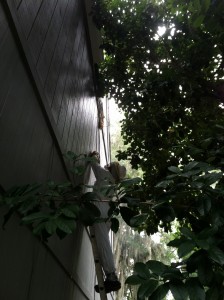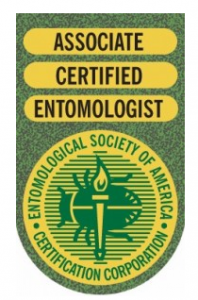Many of you, who can remember that far back, may recall sitting around in a circle in Kindergarten and being asked the question “what would you like to be when you grow up?” Of course, every kid wanted to be a police officer, a fire fighter, a nurse or a veterinarian (in my generation, anyway), but I’d bet money that not many kids ever answered “exterminator”. The job of pest control is not glamorous or tidy and sometimes it can be disgusting or even downright dangerous. Most people “fall into” this occupation out of pure dumb luck (or bad luck, depending upon how you look at it) – maybe they lose a good job, maybe they just can’t find anything else, maybe their cousin owns a pest control company and they’re looking for another sucker to try a hand at it – whatever the reason, they join the ranks of the “bug people”. You don’t choose this job, it chooses you.
Most people who take jobs in pest control don’t last. They quickly discover that getting stung by wasps on a blazing hot summer day or trudging through freezing rain to look for rat burrows behind dumpsters isn’t exactly what they envisioned doing with their lives. Amazingly, some people don’t like the idea of hammer-drilling concrete slab all day in a dark crawlspace full of wolf spiders and then pumping 200 gallons of pesticide under it to kill termites. Some people just don’t have the stomach for it. Besides, exterminators don’t make a whole lot of money, so if someone offers a job that’s an additional dollar an hour or is at least indoors – most bug people will bail out lickity split. Maybe they learned enough to kill some ants on their own kitchen counter top some time in the future or maybe not, but they’re more than willing to leave it at that.
There are two kinds of people who work in this field – those who are warm bodies who move trucks around and get paperwork filled out and those who are tradespeople. The latter are very hard to find. I’m going to go over some suggestions here to help you, the consumer, find a tradesperson exterminator. Please keep in mind that true tradespeople can be found in any company – whether it’s a giant, national franchise company, a small family-owned business or just a single bug person who probably left a giant, national franchise company or small family-owned company to make the money they deserve to make on their own. Every company has its ace. Here’s how to make sure you get that ace:
– When your exterminator pulls up in front of your house, notice if he/she has ladders. They should have a 6 or 8 foot ladder and an extension ladder. If not, how will they get up into your attic to catch mice and/or squirrels or take care of a yellowjacket nest high up in your soffitt? Not all pest control vehicles have ladders, of course, sometimes commercial exterminators, who do work in restaurants and office buildings all day, won’t need more than a small step-ladder. But chances are, if your exterminator has good ladders, it’s because they do a variety of more challenging work and they’re not afraid to use ladders to solve more complex pest problems.
high up in your soffitt? Not all pest control vehicles have ladders, of course, sometimes commercial exterminators, who do work in restaurants and office buildings all day, won’t need more than a small step-ladder. But chances are, if your exterminator has good ladders, it’s because they do a variety of more challenging work and they’re not afraid to use ladders to solve more complex pest problems.
– If you can approach his or her work truck at some point, without feeling like you’re being too intrusive of course, see how neatly it’s kept. A sloppy truck usually means you are going to get sloppy work out of your pest person. Keep in mind, the truck will be in worse shape after 16 stops on a hot August Friday than it will be on a Monday morning, so give a little benefit of the doubt in your assessment.
– Ask your technician a lot of questions. Ask about the products they’ll be using in and around your home. If they can only tell you the brand name of the pesticides and rodenticides they use, you’re probably dealing with a beginner. Brand names are often silly monikers like “Armageddon”, “Annihilation” and the like – they mean nothing – the technician should know the common name of the active ingredient, chemical class and formulation (the most common class of pesticide used by professionals for structural pest control today is synthetic pyrethroids – actives like cyfluthrin, bifenthrin, lambda-cyhalothrin, etcetera. These pyrethroids are formulated into suspensions, emulsions, wettable powders, dusts and granules and each has a very specific application for solving very specific problems – a professional should know this).
– If your technician thinks a pest problem can be solved using nothing but glueboards – be wary. If they think they can solve your Indian meal moth problem by “spraying around”, send them away. If they try to use mouse poison in your kitchen, show them the door. There is no “magic wand” to solve pest problems. Most of the products that your exterminator will use in your home are readily available to every single consumer at any hardware store. You are not paying for a pest professional to “wave a magic wand” of some chemical or another that you can’t buy yourself – you are paying for knowledge and expertise. Ask a lot of questions and make sure your technician is proficient in the trade.
– If you live in a heavily wooded area, or a suburban area and you have a lot of dense shrubbery, your bug person will need a tank sprayer to service your home sufficiently. Most tank sprayers are 25, 50 or 100 gallons and can apply a pesticide at a high psi (pounds per square inch) rate to penetrate heavy shrubbery. A small “B&G” sprayer is an essential tool for pest control, but is not sufficient for insect control in all situations. A pesticide application of a safe, effective synthetic pyrethroid should be performed at least twice a year from a tank sprayer – in Spring and again in Summer. A “B&G” hand-held sprayer is not going to cut it in these buggy months for good control.
– Make sure your technician gets into that dark crawl space under your home. If he/she tries to stand at the opening and squirt a pin stream of bug juice up in there as far as it will go, you have a lazy worker on your hands. Also, if they don’t get up in there, how can you be sure they’re keeping an eye on a possible termite infestation? They’re going to need a good flashlight to do this, also. A tech may tell you that the “termite stake monitors” installed on the exterior of your home will be sufficient for termite inspection, but that is simply not thorough enough.
 – Finally, make sure your exterminator is state certified to apply pesticides. This is a minimum requirement that shows that they have bothered to learn the basics of pest control. Strangely enough, this certification is not always required (a technician can work “under the license” of the company owner) and I have seen technicians fail these tests time and time again and remain employed. Better than just a simple state certification, ask for a technician who has completed an entomology correspondance course or certification (Purdue University offers an excellent correspondance course and technicians can be Certified by the Entomological Society of America, for example). This shows that the technician is serious about their work and they’re not just waiting for a call for that position at Jiffy Lube…
– Finally, make sure your exterminator is state certified to apply pesticides. This is a minimum requirement that shows that they have bothered to learn the basics of pest control. Strangely enough, this certification is not always required (a technician can work “under the license” of the company owner) and I have seen technicians fail these tests time and time again and remain employed. Better than just a simple state certification, ask for a technician who has completed an entomology correspondance course or certification (Purdue University offers an excellent correspondance course and technicians can be Certified by the Entomological Society of America, for example). This shows that the technician is serious about their work and they’re not just waiting for a call for that position at Jiffy Lube…




